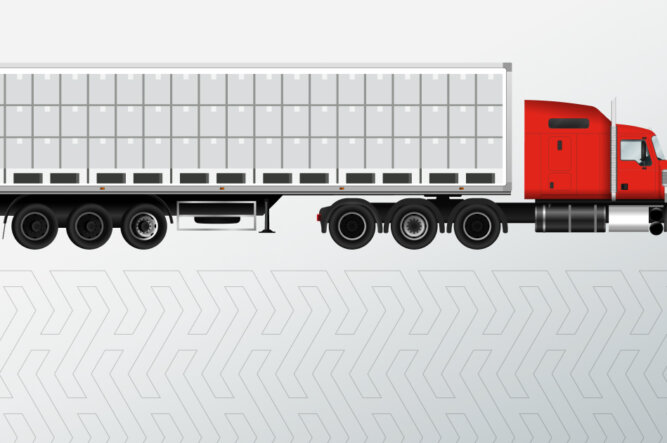Full Truck Loads: 8 Tips for Saving Money

Find your next load
Make more money starting now.
Shippers are always looking for ways to reduce costs. Generally, less-than-truckload (LTL) shipments are more affordable than full truckload (FTL) shipments, because shippers share the costs of cargo space. However, FTL might be a better choice for some carriers.
In this post, we’ll talk about FTL shipping — including limitations, benefits, and how to find the best carriers for your shipments.
What is full truckload shipping?
With full truckload (FTL) shipping, the carrier uses an entire trailer (or nearly an entire truck) for a single customer’s freight. Shippers using FTL get exclusive use of the whole truck and don’t share space with anyone else even if it’s not completely filled.
Since FTL freight takes up an entire truck, there won’t be extra stops on the way to offload other shippers’ products. This reduces handling and the likelihood of damage.
It is usually the most cost-efficient way to ship goods if you have enough freight to contract for an FTL load.
In comparison, less-than-truckload (LTL) shipping combines the freight of multiple customers into one truckload and freight is charged based on the amount of space the cargo uses.
How large are full truckloads
Full truckloads are ideal for six or more pallets or loads over 12,000 pounds.
Without permits, loads can’t exceed 80,000 pounds, including the truck’s weight. Standard 53-foot trailers can transport between 42,000 and 45,000 pounds of cargo.
What are the benefits of full truckloads?
FTL shipping is cost-effective for large shipments, including large or small items in bulk.
Benefits include:
-
Better cost efficiency
The larger the shipment, the more you’ll save versus LTL shipping. That’s because you don’t have to split your freight between multiple smaller shipments. You also save time and labor associated with multiple pickups and drop-offs.
-
Fewer stops
Since FTL shipping uses a dedicated truck for one customer, there are fewer stops. Drivers also use the quickest route, making it ideal for time-sensitive shipments.
-
Improved security
FTL shipments improve freight security because only people directly involved can access the cargo, reducing the risk of theft or damage.
Limited touchpoints reduce the risk of accidents, damaged goods, and delays.
-
Less handling
There are no truck changes with FTL shipping, which means less freight handling overall.
Experienced FTL carriers know how to handle high-risk or delicate freight and offer tracking tools that provide real-time updates on a shipment’s progress.
-
More space
One of the major benefits of FTL shipping is that you get the entire truck, meaning more space for your freight.
You can be more strategic when placing your items in the cargo bed, which makes FTL an excellent option for shipping fragile items.
8 ways to save money on FTLs
1. Know your FTL size.
Your FTL size determines the type of truck and trailer needed for your shipment. FTL shipments typically require a standard semi-trailer. In the US, that means lengths of 48-53 feet, with a width and height of 8.5 feet and 13.5 feet, respectively. Knowing exactly how much space you need will help you pick the right freight service for your shipment and avoid last-minute surprises.
2. Research carriers.
It pays to do your homework when selecting full truckload carriers.
Research different options and read reviews about the carriers you’re considering. Make sure they have experience transporting goods of similar size, shape, and weight to yours and that they understand the importance of load-to-truck ratio.
Other points to research include:
- Pricing
- Turnaround times
- Customer service
- Special endorsements
- Safety records
- Any limitations on service areas
Working with carriers that understand your needs makes it easier to manage your freight transport from start to finish. When you find reliable carriers, stick with them, and ditch the ones that don’t meet expectations.
3. Make FTLs part of your supply chain strategy.
Developing a full truckload strategy for your supply chain helps identify potential cost savings.
For example, working exclusively with a carrier can mean better pricing, discounts, and additional service options like priority loading or delivery scheduling. You should also consider how full truckloads fit into your overall logistics plan.
This could include:
- Managing peak seasons
- Optimizing load sizes
- Planning for unexpected delays
4. Improve lead time.
Lead time is the time between your cargo’s departure and its delivery. Working with full truckloads reduces lead time, because you use larger vehicles with less handling and fewer (or no) stops during transport. Partnering with reliable carriers that offer priority loading or delivery scheduling. These services may come at a premium price, but they provide full visibility of your shipment so you can track it in real time.
5. Avoid detention fees.
Carriers usually charge detention fees when they must wait to load or unload a full truckload shipment. To avoid these fees, ensure your full truckload shipments are ready when carriers arrive, and confirm that your customer will be available to offload the delivery as scheduled. The standard load time is about two or three hours — anything beyond that may result in additional fees. Ensure your shipments have the proper documentation to prevent delays.
6. Automate processes.
One way to automate FTL shipping is through dynamic pricing models that use artificial intelligence (AI) to analyze data from multiple carriers. Tools like load boards give shippers accurate, up-to-date rates based on what’s happening in the market.
For FTL transportation, dynamic pricing uses many factors to determine the going rate, including the:
- Commodity class
- Origin and destination
- Truck type
Shipping software can also help automate workflows and reduce manual tasks by calculating weights or contacting carriers for tracking information.
7. Find the best rates.
There are a few ways shippers can find the best rates. But remember that “best” doesn’t always mean “cheapest.” The best carrier for your load depends on what you’re shipping and the carrier’s experience. Load boards like Truckstop connect shippers to carriers, so you can compare FTL rates for different truck types and multiple carriers and estimate what your shipment will cost.
When planning your shipment, consider the distance, as carriers set trucking rates on a per-mile basis. Other elements that factor into pricing include:
- Current market rates
- Fleet and driver availability
- Freight classification
- Fuel surcharges
- Seasonal demands
- Shipment weight
8. Pay carrier invoices quickly.
Some FTL carriers offer a discount for invoices paid in under 30 days. Many full truckload carriers have moved to electronic payments, making it easier to make fast and secure payments. Always ask your carrier if they offer a quick-pay discount.
Try Truckstop to get the best shipping rates on FTL loads
Full truckload shipping is a cost-effective, efficient, and safe way to transport large loads.
For the best FTL rates, use Truckstop to connect with experienced carriers and get accurate quotes. With our dynamic pricing tools, you can compare full truckload rates from multiple carriers in just a few clicks.
Plus, you’ll get access to freight class lookups and real-time tracking data. Request a free demo to learn more.

Find out how our platform gives you the visibility you need to get more done.
Get helpful content delivered to your inbox.
Schedule a demo.
Find out how our platform gives you the visibility you need to get more done.





